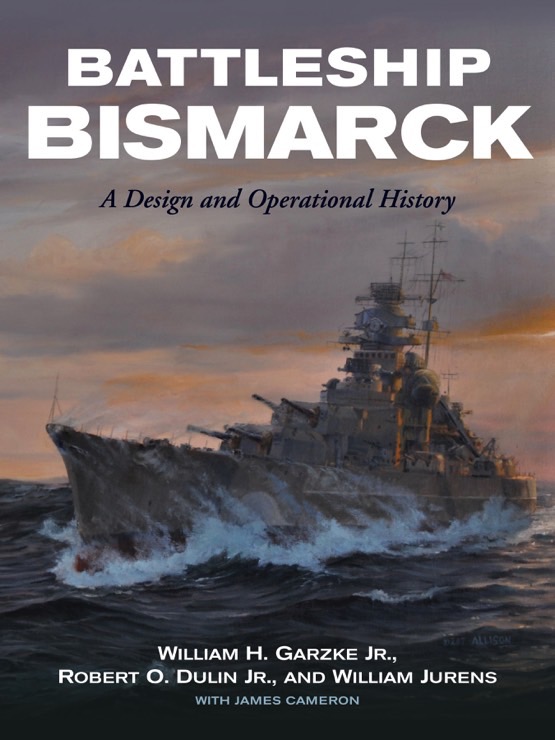
Battleship Bismarck. A Design and Operational History. By William H Garzke Jr, Robert O Dulin Jr and William Jurens (with James Cameron). Seaforth Publications, Barnsley, 2019.
Reviewed by Tim Coyle
Otto von Bismarck, the ‘Iron Chancellor’ who united Germany in the 19thcentury, gave his name to the mighty German battleship which galvanised the Royal Navy in 1941. Bismarck, and its twin, Tirpitz, headed the Kriegsmarine surface threat to allied convoys, together with the battle cruisers Scharnhorst and Gneisenau, the ‘pocket battleships’ and heavy cruisers. Although individually powerful, the German surface fleet was relatively small; however, its presence as a ‘fleet-in-being’ meant the RN and the Royal Air Force had to deploy disproportionate resources to counter the threat these ships represented.
Bismarck’s story is well known in literature and in film; however, Battleship Bismarck is encyclopaedic in its coverage of the life and death of a ship whose reputation lives long after its death. Battleship Bismarck is the result of 56 years of research and presents an unparalleled analysis of the ship’s design, operational career and loss in action.
The book begins with the narrative of the arms limitations applied to Germany under the Versailles Treaty and the 1922 Washington and 1935 London international naval conferences. The battleship limitations were due to expire, and the London conference sought to regularise battleship armament and displacements. Highly political among participating powers, the 35000-ton limitation grew to 45000. This, coupled with Hitler’s assumption of power in 1933 and the Versailles Treaty long since abrogated, empowered the Kriegsmarine to proceed with its new generation of capital ships, including the monster battleships. The book’s initial chapters cover German interwar naval development and Bismarck’s design engineering, armament, protection, fire control, habitability and crew arrangements, launching and workups.
Bismarck’s life was short as it was destroyed on its inaugural war cruise, ‘Operation Rheinubung’. Bismarck, together with the heavy cruiser Prinz Eugen, sortied to attack trans-Atlantic convoys; Bismarck was to engage any escorting battleships while Prinz Eugen would attack the convoy. The planning, staff arrangements and pre-mission manoeuvres are fully detailed, including Hitler’s only visit to the ship.
To set the scene for the battle, the book provides a summary of the state of the RN in 1941. From this follows the prelude to the battle, the contact between the forces, destruction of HMS Hood and the courageous attacks by Swordfish aircraft from HMS Victorious and HMS Ark Royal; the latter attack which crippled Bismarck’s steering. The nine Swordfish from Victorious and 15 Swordfish from Ark Royal all returned despite intense anti-aircraft fire and flying in atrocious conditions; take-off from Ark Royal was in a Force 9 gale.
A major feature of the book is the many images of the wreck by which the authors provide a technical analysis of the effects of British fire together with the location of the wreck on the bottom and its current state of deterioration. As well, there is an analysis of damage to HMS Prince of Wales and a description of the destruction of HMS Hood.
Of Bismarck’s ships company of 2229, only 110 survived to be rescued by the RN. The conditions under which the crew abandoned ship and expired in the oil-covered cold waters are well known and repeated here. A photograph, taken from HMS Dorsetshire, shows over 1000 men in the water, most of which expired through hypothermia. The over 50 years of research in the compilations of the book allowed the authors to use survivors’ accounts of not only the battle but the ship’s organisation and operations.
Of interest is a photograph of 10 Bismarck survivors taken at an internment camp in England in 1942. All are wearing full uniform and look as if they are to proceed ashore on leave. No explanation is given as to how the sailors received their uniforms; however, Red Cross arrangements likely allowed for such a return to dignity for these survivors.
The depth of content, detail and analysis of all aspects of Bismarck’s birth, life and death cannot be fully justified in these few words of review. What it does is provide a fitting memorial to this doomed ship which pitted itself against the might of the RN, regarded as a deadly threat which had to be destroyed regardless of cost. The torpedo, dropped from a flimsy, fabric covered Fairey Swordfish at the limits of endurance, might have just been a pinprick against the ship’s armoured belt; however, it struck a strategic point jamming the steering mechanism. Unable to manoeuvre as a result of this incredible hit, Bismarck expired in agony under overwhelming fire from the avenging RN battle fleet. Bismarck is remembered as a brave ship which died with colours flying, sadly in the service of an evil regime.
Battleship Bismarck is a truly formidable biography; a mighty memorial to a mighty ship.



